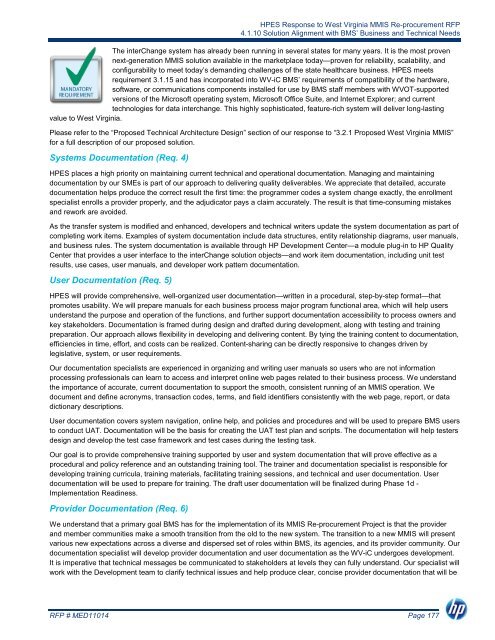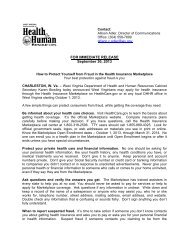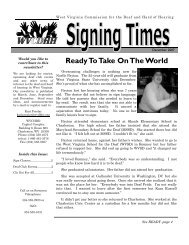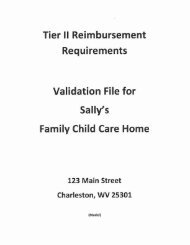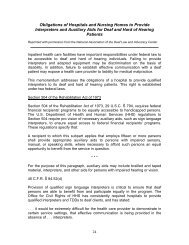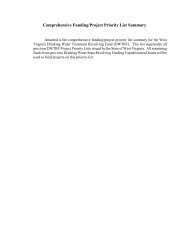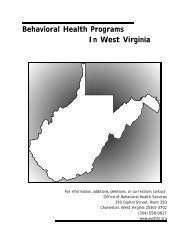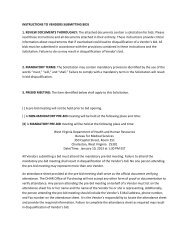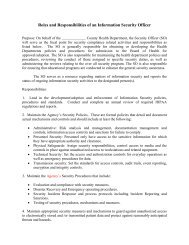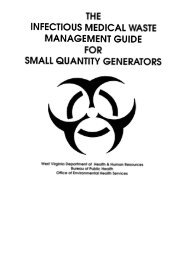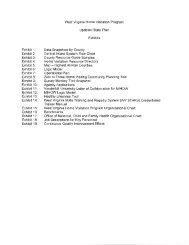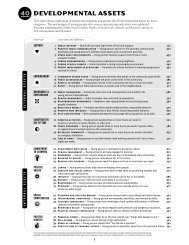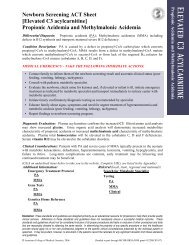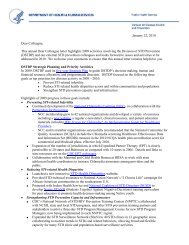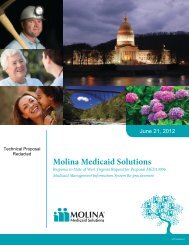HP Enterprise Services - DHHR
HP Enterprise Services - DHHR
HP Enterprise Services - DHHR
Create successful ePaper yourself
Turn your PDF publications into a flip-book with our unique Google optimized e-Paper software.
<strong>HP</strong>ES Response to West Virginia MMIS Re-procurement RFP<br />
4.1.10 Solution Alignment with BMS’ Business and Technical Needs<br />
The interChange system has already been running in several states for many years. It is the most proven<br />
next-generation MMIS solution available in the marketplace today—proven for reliability, scalability, and<br />
configurability to meet today’s demanding challenges of the state healthcare business. <strong>HP</strong>ES meets<br />
requirement 3.1.15 and has incorporated into WV-iC BMS’ requirements of compatibility of the hardware,<br />
software, or communications components installed for use by BMS staff members with WVOT-supported<br />
versions of the Microsoft operating system, Microsoft Office Suite, and Internet Explorer; and current<br />
technologies for data interchange. This highly sophisticated, feature-rich system will deliver long-lasting<br />
value to West Virginia.<br />
Please refer to the “Proposed Technical Architecture Design” section of our response to “3.2.1 Proposed West Virginia MMIS”<br />
for a full description of our proposed solution.<br />
Systems Documentation (Req. 4)<br />
<strong>HP</strong>ES places a high priority on maintaining current technical and operational documentation. Managing and maintaining<br />
documentation by our SMEs is part of our approach to delivering quality deliverables. We appreciate that detailed, accurate<br />
documentation helps produce the correct result the first time: the programmer codes a system change exactly, the enrollment<br />
specialist enrolls a provider properly, and the adjudicator pays a claim accurately. The result is that time-consuming mistakes<br />
and rework are avoided.<br />
As the transfer system is modified and enhanced, developers and technical writers update the system documentation as part of<br />
completing work items. Examples of system documentation include data structures, entity relationship diagrams, user manuals,<br />
and business rules. The system documentation is available through <strong>HP</strong> Development Center—a module plug-in to <strong>HP</strong> Quality<br />
Center that provides a user interface to the interChange solution objects—and work item documentation, including unit test<br />
results, use cases, user manuals, and developer work pattern documentation.<br />
User Documentation (Req. 5)<br />
<strong>HP</strong>ES will provide comprehensive, well-organized user documentation—written in a procedural, step-by-step format—that<br />
promotes usability. We will prepare manuals for each business process major program functional area, which will help users<br />
understand the purpose and operation of the functions, and further support documentation accessibility to process owners and<br />
key stakeholders. Documentation is framed during design and drafted during development, along with testing and training<br />
preparation. Our approach allows flexibility in developing and delivering content. By tying the training content to documentation,<br />
efficiencies in time, effort, and costs can be realized. Content-sharing can be directly responsive to changes driven by<br />
legislative, system, or user requirements.<br />
Our documentation specialists are experienced in organizing and writing user manuals so users who are not information<br />
processing professionals can learn to access and interpret online web pages related to their business process. We understand<br />
the importance of accurate, current documentation to support the smooth, consistent running of an MMIS operation. We<br />
document and define acronyms, transaction codes, terms, and field identifiers consistently with the web page, report, or data<br />
dictionary descriptions.<br />
User documentation covers system navigation, online help, and policies and procedures and will be used to prepare BMS users<br />
to conduct UAT. Documentation will be the basis for creating the UAT test plan and scripts. The documentation will help testers<br />
design and develop the test case framework and test cases during the testing task.<br />
Our goal is to provide comprehensive training supported by user and system documentation that will prove effective as a<br />
procedural and policy reference and an outstanding training tool. The trainer and documentation specialist is responsible for<br />
developing training curricula, training materials, facilitating training sessions, and technical and user documentation. User<br />
documentation will be used to prepare for training. The draft user documentation will be finalized during Phase 1d -<br />
Implementation Readiness.<br />
Provider Documentation (Req. 6)<br />
We understand that a primary goal BMS has for the implementation of its MMIS Re-procurement Project is that the provider<br />
and member communities make a smooth transition from the old to the new system. The transition to a new MMIS will present<br />
various new expectations across a diverse and dispersed set of roles within BMS, its agencies, and its provider community. Our<br />
documentation specialist will develop provider documentation and user documentation as the WV-iC undergoes development.<br />
It is imperative that technical messages be communicated to stakeholders at levels they can fully understand. Our specialist will<br />
work with the Development team to clarify technical issues and help produce clear, concise provider documentation that will be<br />
RFP # MED11014 Page 177


